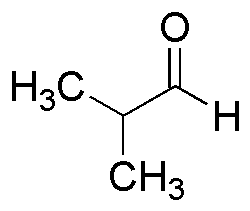Isobutyraldehyde is widely utilized in research focused on:
- Production of Chemicals: It serves as a key intermediate in the synthesis of various chemicals, including butyl acrylate and isobutyl acetate, which are important in the production of paints, coatings, and adhesives.
- Flavor and Fragrance Industry: This compound is used to create flavoring agents and fragrances, providing a sweet, nutty aroma that enhances food products and personal care items.
- Pharmaceuticals: Isobutyraldehyde plays a role in the synthesis of pharmaceutical compounds, helping to develop medications that target specific health conditions.
- Polymer Manufacturing: It is utilized in the production of polymers, contributing to materials with desirable properties for applications in packaging, automotive, and construction industries.
- Research Applications: In laboratories, it is often used as a reagent in organic synthesis, enabling researchers to explore new chemical reactions and develop innovative compounds.
General Information
Properties
Safety and Regulations
Applications
Isobutyraldehyde is widely utilized in research focused on:
- Production of Chemicals: It serves as a key intermediate in the synthesis of various chemicals, including butyl acrylate and isobutyl acetate, which are important in the production of paints, coatings, and adhesives.
- Flavor and Fragrance Industry: This compound is used to create flavoring agents and fragrances, providing a sweet, nutty aroma that enhances food products and personal care items.
- Pharmaceuticals: Isobutyraldehyde plays a role in the synthesis of pharmaceutical compounds, helping to develop medications that target specific health conditions.
- Polymer Manufacturing: It is utilized in the production of polymers, contributing to materials with desirable properties for applications in packaging, automotive, and construction industries.
- Research Applications: In laboratories, it is often used as a reagent in organic synthesis, enabling researchers to explore new chemical reactions and develop innovative compounds.
Documents
Safety Data Sheets (SDS)
The SDS provides comprehensive safety information on handling, storage, and disposal of the product.
Product Specification (PS)
The PS provides a comprehensive breakdown of the product’s properties, including chemical composition, physical state, purity, and storage requirements. It also details acceptable quality ranges and the product's intended applications.
Certificates of Analysis (COA)
Search for Certificates of Analysis (COA) by entering the products Lot Number. Lot and Batch Numbers can be found on a product’s label following the words ‘Lot’ or ‘Batch’.
*Catalog Number
*Lot Number
Certificates Of Origin (COO)
This COO confirms the country where the product was manufactured, and also details the materials and components used in it and whether it is derived from natural, synthetic, or other specific sources. This certificate may be required for customs, trade, and regulatory compliance.
*Catalog Number
*Lot Number
Safety Data Sheets (SDS)
The SDS provides comprehensive safety information on handling, storage, and disposal of the product.
DownloadProduct Specification (PS)
The PS provides a comprehensive breakdown of the product’s properties, including chemical composition, physical state, purity, and storage requirements. It also details acceptable quality ranges and the product's intended applications.
DownloadCertificates of Analysis (COA)
Search for Certificates of Analysis (COA) by entering the products Lot Number. Lot and Batch Numbers can be found on a product’s label following the words ‘Lot’ or ‘Batch’.
*Catalog Number
*Lot Number
Certificates Of Origin (COO)
This COO confirms the country where the product was manufactured, and also details the materials and components used in it and whether it is derived from natural, synthetic, or other specific sources. This certificate may be required for customs, trade, and regulatory compliance.


